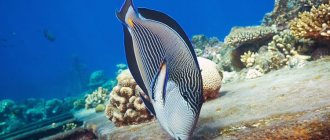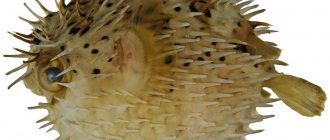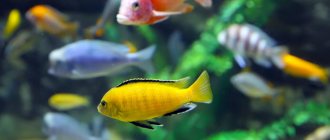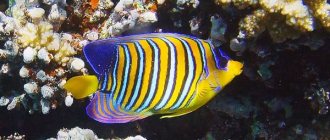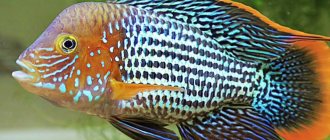For the angler, this is a rogue fish that eats the bait and does not get hooked. For aquarium fish lovers, this is an aquarium decoration.
From this article you will learn why the triggerfish (khazir yam) has such a name, its habitats, fishing techniques and other useful information necessary to catch it.
Content
- 1. General description of the triggerfish
- 2. The name of the triggerfish fish in red languages
- 3. Distribution and habitats of the triggerfish
- 4. Age and size
- 5. Lifestyle
- 5.1. Reproduction - time and characteristics of spawning
- 5.2. Diet - what does the triggerfish eat?
- 6.1. Biting calendar - what time of year and day is it best to catch triggerfish?
- 6.2. What weather is best to fish?
- 6.3. What are the best places to catch triggerfish?
- 6.4. What gear is best for catching khazir yam?
- 6.5. Baits for catching triggerfish
- 6.6.What baits and baits are used to catch Khazir Yam?
- 6.7.How it attaches to a hook
- 6.8. How to catch Khazir Yam correctly? – Basic techniques
- 6.9. The most important points when fishing
General description of the triggerfish
There are more than 40 species of triggerfish. They belong to the order of pufferfish, characterized by their unique body shape.
Having met a triggerfish once, you can’t confuse its appearance with anyone else: an oval body that is strongly flattened laterally, a large head with a small pointed snout, and large lips. The eyes are located closer to the back of the body. The body color is varied and has many shades from black, blue and yellow tones to white and silver. It has strong and sharp teeth (14 on top and 8 on the bottom), capable of biting through a crab shell or breaking a sea shell.
Another unique feature of the fish is the presence of a dorsal fin, sharp as a horn, which rises upward in case of danger.
The scales of the fish are large and smooth, which gives the impression of a solid shell covering its body.
Khazir yam moves slowly in the water space using its pectoral fins, and with the help of its caudal fin it makes a sprinting jerk in case of hunting or danger.
This fish can make specific sounds that resemble grunting. The swim bladder helps her with this.
Nutrition
Having strong teeth, triggerfish feed on solid food. They easily gnaw corals, eat crabs, sea urchins, crustaceans, and so on. They have the habit of not eating whole food, but biting off small pieces.
But not all species are carnivores. For example, the red-toothed triggerfish eats plankton, and the Picasso is content with algae. If fish live in home aquariums, they are fed 3 times a day; overfeeding should not be allowed. You can feed your fish with the following foods:
- meat feed;
- chopped mussels, squid and shrimp;
- seaweed and vitamin supplementation;
Triggerfish fish names in different languages
The name of the fish "triggerfish" in English sounds like triggerfish - "fish with a trigger."
In other languages, the name of the fish is:
- balista (Romanian);
- balliste, balliste cabrio (French);
- ballesta, cachua, escopeta, pejepuerco blanco, peje puerco, pez ballesta, puerco, roncon, sabaco, varraco (Spanish);
- cangulo, maracuguara, porco (Portuguese);
- khanzyr (Arabic);
- peixe-mola (Portuguese);
- pesce palo (Italian);
- schweinedruckerfisch (German);
- trekkervis (Dutch);
- tryckarfisk (Swedish).
Triggerfish distribution and habitats
The habitat of triggerfishes is the waters of the Atlantic, Pacific and Indian oceans. For example, the gray triggerfish or balistes capriscus (trigger) lives in the Mediterranean and Black Seas and differs from its brothers in its silvery patterned body color. This type of triggerfish is also found on the Israeli Mediterranean coast.
You can read more about other species of triggerfish on the Wikipedia pages https://ru.wikipedia.org/wiki/Triggerfish
The triggerfish's habitat is in shallow waters, near coral reefs, rocky areas, rocky soils or dense algae at a depth of 10 to 100 m. This fish can also be found in narrow crevices of underwater reefs and rocks, where it hides.
The only representative of the blue-spotted ocean triggerfish family lives offshore.
Character and lifestyle
Triggerfish have a complex character, which does not allow them to live in flocks. Fish can easily bite through any communication in the aquarium, so keep an eye on the presence of electrical wires. These fish are deprived of a good-natured character; they often show aggression and can damage a person’s hand.
Triggerfish require a large area of space. If you breed fish in an aquarium, its volume should be at least 400 liters. The gray triggerfish species requires a capacity of at least 700 liters, and the titanium triggerfish will feel comfortable in an aquarium of 2000 liters or more.
Titanium triggerfish fish
It is not recommended to keep fish in a reef aquarium because they will happily gnaw on corals. Sand must be placed on the bottom of the aquarium. If you decide to get triggerfish fish, place the aquarium in a well-lit place, aeration and filtration should be at a high level, the fish must have shelter. The water is changed twice a month. In favorable conditions, triggerfish will delight you with their presence for up to 10 years.
Lifestyle
Despite its external beauty, the triggerfish is a capricious and aggressive fish, a loner in life. Home protector and inaccessible prey for other fish...
Triggerfish lead a sedentary and solitary lifestyle; they carefully guard their home from outsiders. Active during the day, hibernating at night.
5.1. Reproduction - time and characteristics of spawning
Breeding time is summer. At this time, the female begins to lay eggs in the dark in deep holes on the seabed, and the male fertilizes her and carefully guards his offspring. The emerging fry are very similar to their parents.
5.2. Diet - what does the triggerfish eat?
The specific structure of the teeth also suggests features in the diet, which includes mollusks and crustaceans, sea urchins, crabs and even corals. Khazir Yam easily bites through the shell of its prey.
Triggerfish in search of food (video author V. Aksakal)
Why is the triggerfish dangerous for humans?
The main danger of fish is during the breeding season. Having laid eggs in the nest, the female vigilantly guards it. The male also takes part in protecting the offspring from enemies. During this period, the diver should not approach the nest, otherwise he may be attacked. At first, the titan will try to scare away uninvited guests by putting its spiked fin on alert. If a person does not understand the threat, the fish will attack and try to bite the alien. Triggerfish teeth are not poisonous, but can seriously injure the soft tissues of the limbs.
The logic behind the behavior of the ballistod has not been well studied. It happened that he went on to attack outside the spawning period. In other situations, the trigger behaved peacefully when the diver approached the nest with eggs and willingly posed for photos. Given the complex nature of the reef inhabitant, residents of coastal areas rightly consider the triggerfish one of the most dangerous inhabitants of the underwater world.
Tip for divers: “The trigger includes the entire column of water above the surface of the nest in the protected zone. It is strictly not recommended to swim over it from above.”
Eating bluefin ballistodes can cause health problems. The fish body is prone to the accumulation of the toxic substance ciguatoxin. This poison is not destroyed by heat treatment and causes both gastrointestinal and neurological disorders. The older the sea dweller, the more serious the disease caused by the consumption of exotic treats.
Interesting, unusual, funny facts about the blue crab
The fish fiercely protects its home and offspring. It is interesting that this protection occurs exclusively vertically, so scuba divers should swim away from the fish to the side, otherwise the triggerfish will bite. The fish warns of its attack by standing on its head and sticking out its dorsal “spike.”
This is how it goes
The most aggressive representatives of the triggerfish are considered to be the “spiny rhinecanth” and the “blue-finned ballistode”, and here is the video
These fish are well protected from attacks by other inhabitants. To protect themselves, they use strategies: First: avoiding the attacker by jerking and demonstrating their sharp spike-dagger. Second: due to their body structure, they quickly hide in narrow crevices, revealing all their “daggers”. It is impossible to pull such an armed fighter out of hiding.
Compatibility
In natural conditions, triggerfish live alone, meeting with relatives only during spawning periods. After successful acclimatization in captivity, the fish will become active and hardy. In a common aquarium with these fish, you should not place invertebrates, which they will certainly eat, as well as aggressive fish that are smaller than them. Triggerfish often conflict with their relatives, so only one individual can be placed in one aquarium. These fish have good compatibility with rock perches, angelfish, surgeonfish, and groupers.
EIBLE-EIBESFELDT CENTROPIG: CONTENTS AND COMPATIBILITY.
IMPERIAL ANGEL: DESCRIPTION, REPRODUCTION, CONTENT, FEEDING, PHOTO, VIDEO.
BUTTERFLY-TWEEZERS: DESCRIPTION, REPRODUCTION, CONTENTS, PHOTO, VIDEO, COMPATIBILITY.
Gastronomy
Despite the difficulty of cleaning the fish, since it has a rather thick skin, dishes made from gray triggerfish meat are popular in many countries.
A five-minute video on how to properly and quickly cut a triggerfish
Some species of triggerfish are dangerous to humans because they contain the poison ciguatoxin in their bodies, which you can read in more detail here https://ru.wikipedia.org/wiki/Ciguatera
The disease manifests itself after a few hours. Signs of poisoning:
- abdominal pain;
- vomit;
- diarrhea;
- numbness of the oral cavity;
- itching;
- photophobia.
Kinds
Triggerfish fish has more than 40 species, we have already looked at some species above, to complete the picture, we will continue and delve into the most popular species:
1. Triggerfish species undulatus . This is a species that has a unique color scheme. A photo of a triggerfish may not convey the beauty that is present in the appearance of the fish. Maximum adult individuals grow to 20-30 centimeters. They require separate housing, that is, they should be bred in a separate aquarium, because they are extremely aggressive towards other types of fish.
2. The royal triggerfish is less aggressive. The aquarium fish reaches a height of 25 centimeters. The scales of this type of fish have a characteristic difference; they are very large in the form of plates.
Pictured is a royal triggerfish
The clown triggerfish has beautiful colors and a maximum height of up to 30 centimeters Owners of large aquariums dream of stocking this species because of its beautiful color. But those who have come across this species say goodbye to clowns just as quickly and without regret, because they are very aggressive and gnaw off everything that is inside the aquarium. They can only be in their home pond; their neighbors are not kept alive for long.
Triggerfish clown fish
4. Picasso triggerfish is an aggressive species, but can get along with large fish. She has a height of up to 30 centimeters. The appearance is bright, which attracts glances and the desire to have it in your aquarium.
Triggerfish Picasso
5. A little boring to watch, but sociable, with a peaceful character, the black triggerfish, whose dimensions reach 25 centimeters.
In the photo there is a black triggerfish fish
6. Peaceful of rag triggerfish often become victims of aggressive neighbors. When small, they measure 4-5 centimeters and grow up to 30 centimeters long.
Rag Triggerfish
In the underwater world, triggerfish have no enemies, because sharp spines become their defense.
